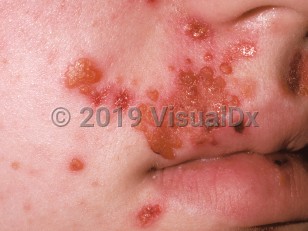Nonbullous impetigo in Adult
Alerts and Notices
Important News & Links
Synopsis

Nonbullous impetigo is a highly contagious superficial skin infection. It is primarily caused by Staphylococcus aureus in industrialized countries. However, group A streptococcus (Streptococcus pyogenes) remains a common cause of nonbullous impetigo in developing countries. In temperate climates, S aureus causes 90%-95% of cases, and S pyogenes or a combination of both S aureus and S pyogenes account for 5%-10% of cases.
Nonbullous impetigo has a predilection for children, affecting around 12% of children, compared to affecting about 5% of adults globally. Impetigo in adults usually results from extensive close contact with infected children or dermatologic conditions that predispose to superficial infection, such as minor trauma, atopic dermatitis, or infestation (eg, scabies). Small epidemics can occur in crowded environments, such as army barracks.
Clinically, impetigo presents as erythematous vesicles and/or pustules that quickly transition into superficial erosions with a characteristic "honey-colored" crust. Lesions are most commonly seen on the face (eg, around the nose and mouth) and extremities. With the exception of mild lymphadenopathy, patients with impetigo generally have no associated systemic symptoms.
Approximately 50% of patients with nonbullous impetigo will experience recurrent episodes within 12 months and require repeated courses of antibiotics.
Although MRSA infection of the skin usually presents as recurrent furunculosis or skin abscesses, MRSA has been shown to cause impetigo in 1%-10% of cases. Culture and sensitivities should always be performed in patients with lesions suspicious for cutaneous infection, and empiric coverage for MRSA should be instituted if clinical suspicion is high.
An infrequent complication of impetigo is acute poststreptococcal glomerulonephritis (APSG), which is caused by particular serotypes of S pyogenes that are nephritogenic. The risk of APSG is not reduced when antibiotic treatment is administered. Importantly, acute rheumatic fever has not been associated with impetigo.
Immunocompromised Patient Considerations:
Pyodermas (cutaneous bacterial infections) including impetigo are quite common in HIV-infected patients. Additionally, pyodermas are found in immunosuppressed transplant patients, especially in the first months following transplant.
Recurrent bouts of impetigo are more common in immunocompromised patients. This may be due to persistent nasal carriage of Staphylococcus, which has been reported to be as high as 50% in patients with HIV infection.
Nonbullous impetigo has a predilection for children, affecting around 12% of children, compared to affecting about 5% of adults globally. Impetigo in adults usually results from extensive close contact with infected children or dermatologic conditions that predispose to superficial infection, such as minor trauma, atopic dermatitis, or infestation (eg, scabies). Small epidemics can occur in crowded environments, such as army barracks.
Clinically, impetigo presents as erythematous vesicles and/or pustules that quickly transition into superficial erosions with a characteristic "honey-colored" crust. Lesions are most commonly seen on the face (eg, around the nose and mouth) and extremities. With the exception of mild lymphadenopathy, patients with impetigo generally have no associated systemic symptoms.
Approximately 50% of patients with nonbullous impetigo will experience recurrent episodes within 12 months and require repeated courses of antibiotics.
Although MRSA infection of the skin usually presents as recurrent furunculosis or skin abscesses, MRSA has been shown to cause impetigo in 1%-10% of cases. Culture and sensitivities should always be performed in patients with lesions suspicious for cutaneous infection, and empiric coverage for MRSA should be instituted if clinical suspicion is high.
An infrequent complication of impetigo is acute poststreptococcal glomerulonephritis (APSG), which is caused by particular serotypes of S pyogenes that are nephritogenic. The risk of APSG is not reduced when antibiotic treatment is administered. Importantly, acute rheumatic fever has not been associated with impetigo.
Immunocompromised Patient Considerations:
Pyodermas (cutaneous bacterial infections) including impetigo are quite common in HIV-infected patients. Additionally, pyodermas are found in immunosuppressed transplant patients, especially in the first months following transplant.
Recurrent bouts of impetigo are more common in immunocompromised patients. This may be due to persistent nasal carriage of Staphylococcus, which has been reported to be as high as 50% in patients with HIV infection.
Codes
ICD10CM:
L01.01 – Non-bullous impetigo
SNOMEDCT:
238374001 – Non-bullous impetigo
L01.01 – Non-bullous impetigo
SNOMEDCT:
238374001 – Non-bullous impetigo
Look For
Subscription Required
Diagnostic Pearls
Subscription Required
Differential Diagnosis & Pitfalls

To perform a comparison, select diagnoses from the classic differential
Subscription Required
Best Tests
Subscription Required
Management Pearls
Subscription Required
Therapy
Subscription Required
References
Subscription Required
Last Reviewed:02/26/2024
Last Updated:02/27/2024
Last Updated:02/27/2024
 Patient Information for Nonbullous impetigo in Adult
Patient Information for Nonbullous impetigo in Adult
Premium Feature
VisualDx Patient Handouts
Available in the Elite package
- Improve treatment compliance
- Reduce after-hours questions
- Increase patient engagement and satisfaction
- Written in clear, easy-to-understand language. No confusing jargon.
- Available in English and Spanish
- Print out or email directly to your patient
Upgrade Today


